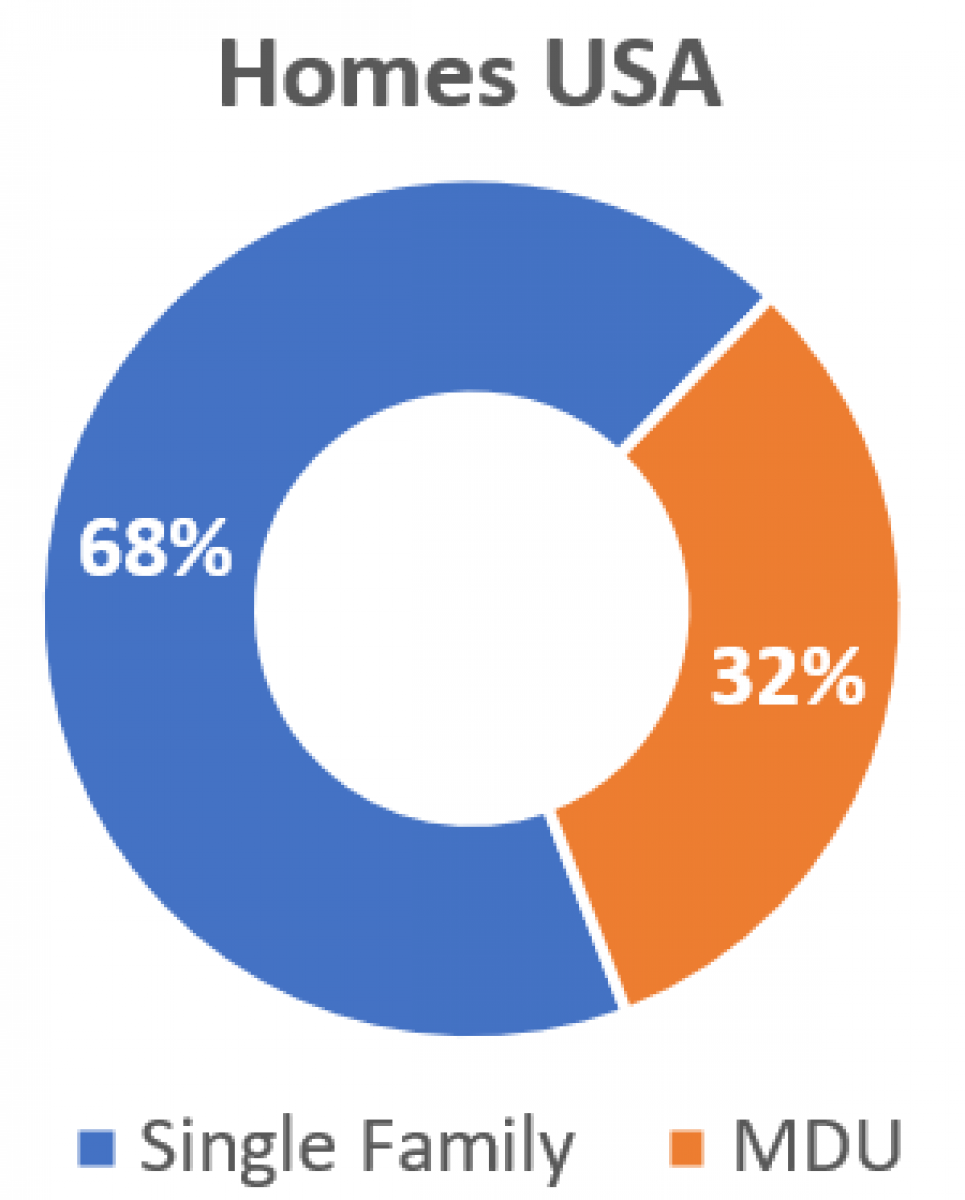
MoCA Access – Multi-gigabit speeds over coax networks
We would like to introduce to you the exciting world of MoCA Access multi-gigabit broadband over coax and our OneNet™ MoCA Broadband solution realizing it and offering the perfect answer for MDUs, Offices, Hospitality & Assisted Care.
Demand for gigabit fiber Internet speeds is growing across all use cases from remote learning through Telecommute and entertainment hence high-speed multi-gigabit internet connectivity at homes and businesses is the new normal.
However, installing fiber to every flat or office can be expensive, labor-intensive and disruptive to customers. The installation of new cable routing in an MDU is incredibly complex and historically, fiber deployments in multiple-dwelling units (MDUs) can be as much as 40 percent of fiber-to-the-building (FTTB) deployment costs. A large number of MDUs and commercial buildings are already pre-wired with coaxial cable (apartment complexes, hotels, and assisted care facilities, and others).
Leveraging existing coaxial cabling infrastructure saves time and is cheaper for operators looking to deliver fiber-like connectivity. Building owners and operators are therefore seeking the most suitable connectivity solution that reduces overall complexity and expense and still bring ubiquitous connectivity to their tenants over the existing coax networks. DOCSIS 3.1 (or higher) can be more expensive to deploy (data/physical infrastructure and CPE) while delivering lower speeds (on average) than Inverto’s MoCA Access solution.
MoCA Access 2.5, on the other hand, is a fiber access extension technology for a cost-effective and less complex upgrade of broadband enabling multi-gigabit networking to any MDU by reusing its existing coax infrastructure.
The Inverto OneNet™ MoCA Access solution is based on MoCA Access 2.5 technology. With our MoCA Access solution, operators can extend fiber to every door and deliver gigabit high-speed residential Internet, 4K video streaming and Internet Protocol television (IPTV) services without the high capital and operational expenses associated with a fiber retrofit.
Key features
The Inverto OneNet™ MoCA Access solution is based on MoCA Access 2.5 technology. With our MoCA Access solution, operators can extend fiber to every door and deliver gigabit high-speed residential Internet, 4K video streaming and Internet Protocol television (IPTV) services without the high capital and operational expenses associated with a fiber retrofit.
| Use Coax wiring already on premise Most commercial and MDU properties have coaxial connectivity |
||
 |
Everyone wants High-Speed Internet Average speeds around the world 100 to 400 Mbps In the Americas, ~30% of operators offer 1Gbps+ speeds. |
|
 |
Cost Effective & Easy to Install No need to pull new fiber or structured cable through the building. Connect services in minutes. |
|
 |
Sustainable Power Save (sleep mode) For every 1 meter of cable not manufactured, 300g of CO2 are saved. |



OneNet™ MoCA Access - Solution Overview
Inverto’s OneNet™ MoCA Access solution offers a cost effective and easy to deploy fiber extension technology that is ideal for operators and ISPs that are installing fiber-to-the-basement (FTTB) and want to use the existing coax for connection to each apartment or unit. It is equally ideal for system integrators operating in market segments such as hospitality/hotels, restaurants, offices, and any other buildings wired with coax. With FTTx being deployed across many service areas, having to re-cable a multi-dwelling building, hotel and such properties is costly and time consuming.
Inverto’s OneNet™ MoCA Access solution offers a cost effective and easy to deploy fiber extension technology that is ideal for operators and ISPs that are installing fiber-to-the-basement (FTTB) and want to use the existing coax for connection to each apartment or unit. It is equally ideal for system integrators operating in market segments such as hospitality/hotels, restaurants, offices, and any other buildings wired with coax. With FTTx being deployed across many service areas, having to re-cable a multi-dwelling building, hotel and such properties is costly and time consuming.
Our OneNet™ MoCA Access solution leverages the internal (pre-existing) coaxial network in the building to provide High-Speed Internet Services, faster and more economically than any other solution.
The solution allows service providers to also earn points toward green initiatives, cheaper and faster to deploy with innovative power saving features, and no re-cabling required (save on CapEx and OpEx).
The MoCA Access Controller accommodates 2x SFP/SFP+ cages with either 10Gbps or 1Gbps (load-balanced) capacity for northbound connectivity. The SFP modules can be Optical, Copper or Coax, making our solution “media-agnostic” providing the flexibility to connect to any type of demarcation networking equipment be it an OLT, an ONU or an Ethernet switches and full interoperability with such existing equipment. The MoCA Access Controller features an energy efficient, environmentally rugged enclosure (IP66 compliant) for outdoor or indoor use.
The MoCA Access Controller has four 75Ω RF outputs, each branch can serve up to 31 CNU’s (Coax Network Unit) delivering up to 10 Gbps of capacity to 124 users. Each RF output has a reach of 275m (900 ft) well suited for most use cases. Controllers can be cascaded to scale up beyond 124 users.
The CNU’s (at the subscriber location) have the option to Reverse-Power the MoCA Access Controller. This greatly simplifies its outdoor installation (as no power supplies or metering equipment needed) and saves as much as 40% in energy costs over traditional solutions.
In addition, a cloud-based Network Management Software tool provides a remote management solution for control and monitoring of all the devices across the service area (local management is also possible via direct PC connection to the MoCA Access Controller on the premises).
Summary of Advantages
■ Full ACCESS, Cost-competitive Carrier-Grade solution
■ Cloud-based Remote Management software tool (RESTful API’s available).
■ Can be seamlessly integrated with OSS/BSS
■ Background SW updates
■ Use existing coax wiring in the building (with MoCA-rated splitters)
■ IP66 Compliant (Splash-proof)
■ Superior heat dissipation.
■ Agnostic to the WAN connection (P2P Fiber, GPON, Ethernet, etc.)
■ Dual SFP cages for redundancy or load balancing
■ SFP modules available: Fiber (GPON/EPON/XGSPON), Ethernet, and Coax
■ No BW bottlenecks: up to 10Gbps can be shared across 124 or more users with symmetrical
multi-gigabit peak throughput per user.
■ Save on external plant powering equipment (Reverse Power Feature)
■ Faster to deploy (no need to re-wire the building with Fiber or Ethernet)
■ CNU’s with or without built-in Wi-Fi AP, can be installed in minutes, saving hotels the cost of
shutting down entire wings for upgrad
■ Great for Green Initiatives:
- Consumes 40% less power than other solutions.
- Sleep Mode: even less power consumption when CNU’s are not in use.
- No New Cable: for every 1m not manufactured it saves 300g of CO2
Interested in reading about an actual MoCA OneNet™ MoCA Access case study?
Please follow this link
Deployment Scenarios
High-speed data-only Multi-gigabit Internet service
By utilizing a full 500 MHz band, either Band E (400~900 MHz) or the extended Band D (1125 ~ 1675 MHz), of the MoCA Access 2.5 stack, the Our OneNet™ MoCA Access Controller can deliver peak throughput of 2.5 Gbps over each of its output ports. Each port of the Our OneNet™ MoCA Access Controller implements a MoCA Access Segment and can support up to 31 CNUs and deliver multi-gigabit internet service to each unit (Diagram 1 below).
This deployment scenario offers high speed gigabit internet for a variety of applications including UHD/4K video streaming, IPTV, Gaming and/or video conferencing.
High-speed data-only Multi-gigabit Internet service
By utilizing a full 500 MHz band, either Band E (400~900 MHz) or the extended Band D (1125 ~ 1675 MHz), of the MoCA Access 2.5 stack, the Our OneNet™ MoCA Access Controller can deliver peak throughput of 2.5 Gbps over each of its output ports. Each port of the Our OneNet™ MoCA Access Controller implements a MoCA Access Segment and can support up to 31 CNUs and deliver multi-gigabit internet service to each unit (Diagram 1 below).
This deployment scenario offers high speed gigabit internet for a variety of applications including UHD/4K video streaming, IPTV, Gaming and/or video conferencing.
Pure MoCA Access scenario
(no CATV / Sat TV co-existing on the coax)

Broadcast TV coexistence deployment scenarios
Use cases can often involve facilities that already have broadcast TV Service on premise (Analog or Digital) and typically occupying the following frequency ranges:
CATV ■
- UHF: 470 - 790 MHz
- VHF: 174 - 230 MHz
■ OTA TV (Terrestrial)
- STD: 950 MHz - 2150 MHz
Satellite (DTH) ■
- 54 MHz - 860 MHz
Depending on the use case, Diplexers or Triplexers that combine or split various broadcast TV sources & MoCA Access services may be necessary (both at the injection and extraction points) to ensure that the MoCA Access signals being properly overlayed onto the coaxial network without interfering with existing video services. There may also be cases where RF Amplification is needed to achieve proper TV signal levels throughout a property, cases where RF passives in the building may be required to support up to 2.4GHz and cases requiring DC Power Passing - 1A typ. or up to 3A when Reverse Power Feed is exercised (from CNUs to the Controller).
CATV/OTA (Terrestrial) TV Scenarios
MoCA Access supports CATV/OTA (Terrestrial) TV by utilizing the Extended Band D as shown below:
MoCA Access supports CATV/OTA (Terrestrial) TV by utilizing the Extended Band D as shown below:

In cases where there are CATV Video services in the building, the coaxial runs may require amplification of the TV signals to deliver proper RF levels to each subscriber.
The OneNet™ MoCA Diplexer (OMD) - Low-loss MoCA Access compatible Diplexer can be used to allow pass-through of existing CATV (Analog or Digital TV) signals while injecting the high speed MoCA Access Data Service over the Extended D-Band from 1.1 to 1.7 GHz – offering the flexibility needed to support the varying coax distribution networks that can be found in the field.
The OMDs can be used with various coax adapters (F or 5/8”) and can also pass AC Power to feed the CATV amplifiers (60Vac - 50/60Hz - 15A) with extremely low hum modulation.
For distances of up to 275m (900 feet) there may be several RF Amplifiers (daisy-chain) and an MDB will be required at each location.
Legacy broadcast TV scenarios using amplifiers (active coax distribution network) are not compatible with the Reverse Power feature (MoCA Access Controller and CNU). The Reverse Power Feed can be used only over passive coax networks.
The following diagram describes a typical CATV deployment scenario with CATV RF amplifiers:
The OneNet™ MoCA Diplexer (OMD) - Low-loss MoCA Access compatible Diplexer can be used to allow pass-through of existing CATV (Analog or Digital TV) signals while injecting the high speed MoCA Access Data Service over the Extended D-Band from 1.1 to 1.7 GHz – offering the flexibility needed to support the varying coax distribution networks that can be found in the field.
The OMDs can be used with various coax adapters (F or 5/8”) and can also pass AC Power to feed the CATV amplifiers (60Vac - 50/60Hz - 15A) with extremely low hum modulation.
For distances of up to 275m (900 feet) there may be several RF Amplifiers (daisy-chain) and an MDB will be required at each location.
Legacy broadcast TV scenarios using amplifiers (active coax distribution network) are not compatible with the Reverse Power feature (MoCA Access Controller and CNU). The Reverse Power Feed can be used only over passive coax networks.
The following diagram describes a typical CATV deployment scenario with CATV RF amplifiers:
A typical CATV scenario
(4x 2.5Gbps MoCA Access Segments over Extended Band D)
(4x 2.5Gbps MoCA Access Segments over Extended Band D)

OneNet™ OMD Key Features
■ Compact Design, Outdoor Water-Proof Enclosure
■ Accommodates 5/8 or F-type adapters.
■ Impedance: 75 Ohm (>15.5 dB RL)
■ Insertion Loss: < 2.5 dB
■ Isolation: >80 dB (MoCA) & >52 dB (TV-MoCA)
■ AC Power-Passing: 60Vac - 50/60Hz @ 15A max.
■ Accommodates 5/8 or F-type adapters.
■ Impedance: 75 Ohm (>15.5 dB RL)
■ Insertion Loss: < 2.5 dB
■ Isolation: >80 dB (MoCA) & >52 dB (TV-MoCA)
■ AC Power-Passing: 60Vac - 50/60Hz @ 15A max.
Satellite TV Scenarios
MoCA Access can coexist with a Satellite TV service by utilizing 3x 100 MHz channels of Band E (400 ~ 900 MHz) as shown below:
MoCA Access can coexist with a Satellite TV service by utilizing 3x 100 MHz channels of Band E (400 ~ 900 MHz) as shown below:

source: MoCA Alliance MoCA 2.0/2.5 Specification
When the Reverse Power Feed (RPF) is selected for the MoCA Access Controller, all CNU’s in the installation must also have the RPF; CNU’s without the RPF should not be mixed in the population.
However, in cases where RF Amplifiers are needed, it is recommended that they are powered directly from the building AC grid and not use the coaxial network to carry said AC Power. Furthermore, using Power Passing, TV-Sat Splitters/Combiners is the most cost-effective way to add TV services and MoCA signals together.
In cases where RF Amplifiers are needed, it is recommended that they are powered directly from the building AC grid and not use the coaxial network to carry said AC Power. Furthermore, using Power Passing, TV-Sat Splitters/Combiners is the most cost-effective way to add TV services and MoCA signals together.
When the Reverse Power Feed (RPF) is selected for the MoCA Access Controller, all CNU’s in the installation must also have the RPF; CNU’s without the RPF should not be mixed in the population.
However, in cases where RF Amplifiers are needed, it is recommended that they are powered directly from the building AC grid and not use the coaxial network to carry said AC Power. Furthermore, using Power Passing, TV-Sat Splitters/Combiners is the most cost-effective way to add TV services and MoCA signals together.
In cases where RF Amplifiers are needed, it is recommended that they are powered directly from the building AC grid and not use the coaxial network to carry said AC Power. Furthermore, using Power Passing, TV-Sat Splitters/Combiners is the most cost-effective way to add TV services and MoCA signals together.
When the Reverse Power Feed (RPF) is selected for the MoCA Access Controller, all CNU’s in the installation must also have the RPF; CNU’s without the RPF should not be mixed in the population.
TV Satellite: Diplexer / Combiner recommended specifications
■ Port 1: 950-2150 MHz (Sat-TV)
■ Port 2: 40-860 MHz (MoCA Access)
■ Port 3: 40 to 2150 MHz (Combined)
■ DC Power Passing required for Reverse Powering applications.
The following diagram describes a typical deployment scenario with Satellite TV service available on the coax network:
■ Port 1: 950-2150 MHz (Sat-TV)
■ Port 2: 40-860 MHz (MoCA Access)
■ Port 3: 40 to 2150 MHz (Combined)
■ DC Power Passing required for Reverse Powering applications.
The following diagram describes a typical deployment scenario with Satellite TV service available on the coax network:
Satellite TV scenario
(2x 2.5Gbps MoCA Access Segments over Band E)

(2x 2.5Gbps MoCA Access Segments over Band E)

OneNet™ Network Management System
The OneNet™ MoCA NMS is an advanced cloud-based service offering 24/7 real-time remote monitoring and device management of your networks from anywhere, anytime.
OneNet™ NMS Dashboard


The network management system features a dashboard displaying field statistics on the status of connections and the actual Rx/Tx throughputs. The system offers centralized monitoring of OneNet™ MoCA Access Controllers and subscribers’ CNUs. It lists all the equipment deployed in the field, displays their location on a map and allows direct access to its configuration parameters, monitoring data, diagnostics, and maintenance operations. It also allows you to set up alerts and receive notifications on connectivity issues so you can address them before they turn into customers’ complaints. For social areas and hospitality plants or hotels, it also features a centralized Wi-Fi management to help you set up and control keys for public and private Wi-Fi access points.
OneNet™ NMS Product info page

MoCA Access vs. G.hn
G.hn is an alternative Ethernet-over-Coax technology based on an ITU standard. The following table summarizes the key advantages of MoCA Access 2.5 over G.hn for deployments over coax networks:
G.hn is an alternative Ethernet-over-Coax technology based on an ITU standard. The following table summarizes the key advantages of MoCA Access 2.5 over G.hn for deployments over coax networks:
| Parameter | MoCA Access 2.5 | G.hn (wave-2) |
| MAC Throughput | 2.5Gbps | 1.7Gbps |
| Channel Bandwidth | 300-500 MHz | 0-200 MHz (coax) |
| Operation Range | 400 – 1675 MHz | 0-200 MHz (coax) |
| Number of nodes per segment | 32 | 16 |
| (Controller + CPEs) | ||
| Co-existence with CATV/OTA services | Fully supported, 2.5Gbps throughput guaranteed using extended Band D | Overlapping CATV channels; decrease in total throughput depends on the frequency range allocated for CATV. |
As can be drawn from the above comparison table, G.hn requires two times the number of ports to support the same number of CPE units, delivers lower total throughput and offers a limited co-existence with CATV services over a coax network, making it a less attractive technology for delivering high-speed multi-gigabit internet to MDUs, offices or any other building wired with coax.